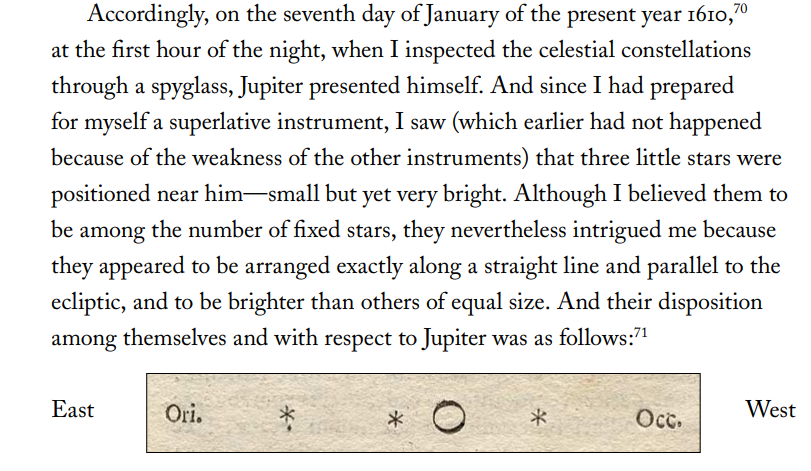 |
| Animation of Jupiter's three nearest moons over 2.5 hours; Credit: Purnendu Gupta; Sep 26, 2022 |
Four Nights in Padua
 |
| Source: English Translation of Sidereus Nuncius by Albert Van Helden ©1989 by The University of Chicago From: reed college |
 |
Worlds of Fire and Ice
Four hundred and twelve years later, the garden variety backyard astrophotographer can detect the motions in one night over the span of two and a half hours. The animation above is a composite of four individual stills, each made using the "lucky imaging" method to get around the roiling currents in the earth’s atmosphere. Each of the four frames is derived from a video clip at 30 frames per second, running for about a minute each. Special software then culls the highest quality ones and creates a master frame by adding them up.
Earth based imaging aside, thanks to several spacecraft missions in the past 50 years, we know a lot about Jupiter and the Galilean moons.
 |
| A Galileo spacecraft image shows volcanic activity on Io Source: NASA/JPL. 1999 |
to "tides" in its solid surface up to 300 feet high, generating enough heat to give rise to volcanic activity. In fact Io has one of the highest volcanic activity in the entire solar system.
Ganymede is the largest moon in the solar system (larger than Mercury), and is the only moon known to have its own internally generated magnetic field.
Callisto’s surface is extremely heavily cratered and ancient — a record of events from the early history of the solar system. Ganymede and Callisto, like Europa, have oceans, but they are deeper and less accessible. Their seafloors are believed to be covered with thick layers of ice - which when formed under pressure, sink rather than float
 |
| Europa surface shows domes and ridges, as well as a region of disrupted terrain including crustal plates which are thought to have broken apart and "rafted" into new positions. Source; Nasa/JPL |
The most intriguing of the moons is perhaps Europa. It's surface is mostly water-ice. The icy crust is believed to cover a global water ocean. This moon according to our expert estimates has the highest potential for having a habitable ocean very much like Earth’s.
Clipper of (Alien) Clouds
NASA is currently preparing the Europa Clipper mission targeted for launch in 2024. It is expected to arrive by 2030. While it is not a life detecting mission, it will be in orbit and perform close flyby-s of this icy world looking for evidence of life supporting environments.
The spacecraft will the largest ever that NASA has built for a planetary mission. Its solar arrays will span 100 feet, wider than the length of a basketball court. With fuel, it will weight over 6 thousand kilograms - the weight of one and a half average American car. An array of nine science instruments that include high resolution cameras, magnetometers, thermal imagers, mass spectrometer, ice penetrating radar, surface dust mass analyzers will help it probe Europa.
Will its findings be as revolutionary as that of a middle aged man from four centuries ago armed with a home made gizmo and a beautiful mind?
We hope to know in another 8 years.
 |
| Galileo's Telescopes at the Galileo Museum, Florence, Italy Photo Credit: Purnendu Gupta (Aug 18, 2022) |
References:
- https://solarviews.com/eng/galdisc.htm
- https://www.nasa.gov/sites/default/files/files/Moons_of_Jupiter_Lithograph.pdf
- Meet Europa Clipper - NASA
Further Reading:
- Galileo timeline
- Siderus Nunicus - Internet Archive
- House of Galileo Galilei in Padua
- Simon Marius
- NASA on Europa
No comments:
Post a Comment